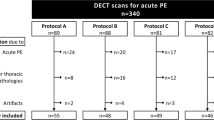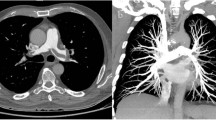Abstract
Objectives
To retrospectively compare semi-qualitative and quantitative CT pulmonary angiography (CTPAs) image metrics testing diagnostic performance between protocols performed by 20 or 40 ml of contrast medium (CM) in patients with suspected pulmonary embolism (PE).
Methods
A total of 102 CTPAs performed by 20 ml (ultra-low volume: ULV) and 74 CTPAs performed by 40 ml (low volume: LV) protocol for the diagnosis of clinically suspected PE performed between October 2012 and September 2013 were retrieved. High-concentration CM (Iomeprol 400 mgI/ml) was injected at 3 ml/s (iodine delivery rate 1.2 mgI/s). Two radiologists (blinded and independent) semi-qualitatively scored vascular enhancement and image noise according to a five-point visual scoring system. Quantitative analysis was performed by regions of interest quantifying densitometric parameters, such as central and peripheral pulmonary arteries vascular contrast enhancement (CE, threshold for diagnostic CE ≥ 250 HU), and metrics for image noise. Continuous variables were compared by the Student’s t test between groups if normally distributed while categorical variables were analyzed with the Chi-squared test. Interobserver agreement was calculated by the weighted kappa test; correlation coefficients were calculated using Pearson’s correlation tests.
Results
The semi-qualitative scores for central and peripheral pulmonary arteries vascular CE were sufficient by ULV, yet inferior than LV (p < 0.001). Semi-qualitative image noise was comparable between ULV and LV, and the interobserver agreement was only fair for quality of peripheral vessels. Agreement on nondiagnostic semi-qualitative parameters was seen in 9/102 (8.8%) ULV CTPAs, in particular associated with massive PE (2/9), pleuro-pulmonary abnormalities (5/9) or without major abnormalities (2/9). Quantitative analysis showed that mean CE was lower in ULV group (p < 0.001), though greater than the diagnostic threshold of 250 HU in both groups.
Conclusions
Diagnostic vascular CE (> 250 HU) was obtained in both 20 ml and 40 ml CTPAs. CTPA by 20 ml of CM rendered diagnostic CE for the assessment of pulmonary arteries in patients with clinical suspicion of acute PE. Decreased image quality was mostly associated with massive PE or concomitant pleuro-parenchymal abnormalities.





Similar content being viewed by others
References
Konstantinides SV, Torbicki A, Agnelli G, Danchin N, Fitzmaurice D, Galie N, Gibbs JS, Huisman MV, Humbert M, Kucher N, Lang I, Lankeit M, Lekakis J, Maack C, Mayer E, Meneveau N, Perrier A, Pruszczyk P, Rasmussen LH, Schindler TH, Svitil P, Vonk Noordegraaf A, Zamorano JL, Zompatori M, Task Force for the D, Management of Acute Pulmonary Embolism of the European Society of C (2014) 2014 ESC guidelines on the diagnosis and management of acute pulmonary embolism. Eur Heart J 35(43):3033–3069. https://doi.org/10.1093/eurheartj/ehu283
Heit JA, Spencer FA, White RH (2016) The epidemiology of venous thromboembolism. J Thromb Thrombolysis 41(1):3–14. https://doi.org/10.1007/s11239-015-1311-6
Remy-Jardin M, Pistolesi M, Goodman LR, Gefter WB, Gottschalk A, Mayo JR, Sostman HD (2007) Management of suspected acute pulmonary embolism in the era of CT angiography: a statement from the Fleischner society. Radiology 245(2):315–329. https://doi.org/10.1148/radiol.2452070397
Turedi S, Erdem E, Karaca Y, Tatli O, Sahin A, Turkmen S, Gunduz A (2016) The high risk of contrast-induced nephropathy in patients with suspected pulmonary embolism despite three different prophylaxis: a randomized controlled trial. Acad Emerg Med 23(10):1136–1145. https://doi.org/10.1111/acem.13051
Tao SM, Wichmann JL, Schoepf UJ, Fuller SR, Lu GM, Zhang LJ (2016) Contrast-induced nephropathy in CT: incidence, risk factors and strategies for prevention. Eur Radiol 26(9):3310–3318. https://doi.org/10.1007/s00330-015-4155-8
Stacul F, van der Molen AJ, Reimer P, Webb JA, Thomsen HS, Morcos SK, Almen T, Aspelin P, Bellin MF, Clement O, Heinz-Peer G, Contrast Media Safety Committee of European Society of Urogenital R (2011) Contrast induced nephropathy: updated ESUR Contrast Media Safety Committee guidelines. Eur Radiol 21(12):2527–2541. https://doi.org/10.1007/s00330-011-2225-0
Beckett KR, Moriarity AK, Langer JM (2015) Safe use of contrast media: what the radiologist needs to know. Radiographics 35(6):1738–1750. https://doi.org/10.1148/rg.2015150033
van der Molen AJ, Reimer P, Dekkers IA, Bongartz G, Bellin MF, Bertolotto M, Clement O, Heinz-Peer G, Stacul F, Webb JAW, Thomsen HS (2018) Post-contrast acute kidney injury—part 1: definition, clinical features, incidence, role of contrast medium and risk factors: Recommendations for updated ESUR Contrast Medium Safety Committee guidelines. Eur Radiol 28(7):2845–2855. https://doi.org/10.1007/s00330-017-5246-5
Szucs-Farkas Z, Christe A, Megyeri B, Rohacek M, Vock P, Nagy EV, Heverhagen JT, Schindera ST (2014) Diagnostic accuracy of computed tomography pulmonary angiography with reduced radiation and contrast material dose: a prospective randomized clinical trial. Invest Radiol 49(4):201–208. https://doi.org/10.1097/RLI.0000000000000016
Faggioni L, Neri E, Sbragia P, Pascale R, D’Errico L, Caramella D, Bartolozzi C (2012) 80-kV pulmonary CT angiography with 40 mL of iodinated contrast material in lean patients: comparison of vascular enhancement with iodixanol (320 mg I/mL)and iomeprol (400 mg I/mL). AJR Am J Roentgenol 199(6):1220–1225. https://doi.org/10.2214/AJR.11.8122
Wu CC, Lee EW, Suh RD, Levine BS, Barack BM (2012) Pulmonary 64-MDCT angiography with 30 mL of IV contrast material: vascular enhancement and image quality. AJR Am J Roentgenol 199(6):1247–1251. https://doi.org/10.2214/AJR.12.8739
Delesalle MA, Pontana F, Duhamel A, Faivre JB, Flohr T, Tacelli N, Remy J, Remy-Jardin M (2013) Spectral optimization of chest CT angiography with reduced iodine load: experience in 80 patients evaluated with dual-source, dual-energy CT. Radiology 267(1):256–266. https://doi.org/10.1148/radiol.12120195
Saade C, Bourne R, El-Merhi F, Somanathan A, Chakraborty D, Brennan P (2013) An optimised patient-specific approach to administration of contrast agent for CT pulmonary angiography. Eur Radiol 23(11):3205–3212. https://doi.org/10.1007/s00330-013-2919-6
Hendriks BM, Kok M, Mihl C, Bekkers SC, Wildberger JE, Das M (2016) Individually tailored contrast enhancement in CT pulmonary angiography. Br J Radiol 89(1061):20150850. https://doi.org/10.1259/bjr.20150850
Lu GM, Luo S, Meinel FG, McQuiston AD, Zhou CS, Kong X, Zhao YE, Zheng L, Schoepf UJ, Zhang LJ (2014) High-pitch computed tomography pulmonary angiography with iterative reconstruction at 80 kVp and 20 mL contrast agent volume. Eur Radiol 24(12):3260–3268. https://doi.org/10.1007/s00330-014-3365-9
Horehledova B, Mihl C, Milanese G, Brans R, Eijsvoogel NG, Hendriks BMF, Wildberger JE, Das M (2018) CT angiography in the lower extremity peripheral artery disease feasibility of an ultra-low volume contrast media protocol. Cardiovasc Interv Radiol 41(11):1751–1764. https://doi.org/10.1007/s00270-018-1979-z
Aschoff AJ, Catalano C, Kirchin MA, Krix M, Albrecht T (2017) Low radiation dose in computed tomography: the role of iodine. Br J Radiol 90(1076):20170079. https://doi.org/10.1259/bjr.20170079
Hendriks BMF, Schnerr RS, Milanese G, Jeukens C, Niesen S, Eijsvoogel NG, Wildberger JE, Das M (2019) Computed tomography pulmonary angiography during pregnancy: radiation dose of commonly used protocols and the effect of scan length optimization. Korean J Radiol 20(2):313–322. https://doi.org/10.3348/kjr.2017.0779
Boos J, Kropil P, Lanzman RS, Aissa J, Schleich C, Heusch P, Sawicki LM, Antoch G, Thomas C (2016) CT pulmonary angiography: simultaneous low-pitch dual-source acquisition mode with 70 kVp and 40 ml of contrast medium and comparison with high-pitch spiral dual-source acquisition with automated tube potential selection. Br J Radiol 89(1062):20151059. https://doi.org/10.1259/bjr.20151059
Wittram C, Maher MM, Yoo AJ, Kalra MK, Shepard JA, McLoud TC (2004) CT angiography of pulmonary embolism: diagnostic criteria and causes of misdiagnosis. Radiographics 24(5):1219–1238. https://doi.org/10.1148/rg.245045008
Godoy MC, Heller SL, Naidich DP, Assadourian B, Leidecker C, Schmidt B, Vlahos I (2011) Dual-energy MDCT: comparison of pulmonary artery enhancement on dedicated CT pulmonary angiography, routine and low contrast volume studies. Eur J Radiol 79(2):e11–e17. https://doi.org/10.1016/j.ejrad.2009.12.030
Bae KT, Tao C, Gurel S, Hong C, Zhu F, Gebke TA, Milite M, Hildebolt CF (2007) Effect of patient weight and scanning duration on contrast enhancement during pulmonary multidetector CT angiography. Radiology 242(2):582–589. https://doi.org/10.1148/radiol.2422052132
Horehledova B, Mihl C, Milanese G, Brans R, Eijsvoogel NG, Hendriks BMF, Wildberger JE, Das M (2018) CT Angiography in the lower extremity peripheral artery disease feasibility of an ultra-low volume contrast media protocol. Cardiovasc Interv Radiol. https://doi.org/10.1007/s00270-018-1979-z
Watson PF, Petrie A (2010) Method agreement analysis: a review of correct methodology. Theriogenology 73(9):1167–1179. https://doi.org/10.1016/j.theriogenology.2010.01.003
Hemmett J, Er L, Chiu HH, Cheung C, Djurdjev O, Levin A (2015) Time to revisit the problem of CIN? The low incidence of acute kidney injury with and without contrast in hospitalized patients: an observational cohort study. Can J Kidney Health Dis 2:38. https://doi.org/10.1186/s40697-015-0073-6
McDonald JS, McDonald RJ, Carter RE, Katzberg RW, Kallmes DF, Williamson EE (2014) Risk of intravenous contrast material-mediated acute kidney injury: a propensity score-matched study stratified by baseline-estimated glomerular filtration rate. Radiology 271(1):65–73. https://doi.org/10.1148/radiol.13130775
Radon MR, Kaduthodil MJ, Jagdish J, Matthews S, Hill C, Bull MJ, Morcos SK (2011) Potentials and limitations of low-concentration contrast medium (150 mg iodine/ml) in CT pulmonary angiography. Clin Radiol 66(1):43–49. https://doi.org/10.1016/j.crad.2010.05.011
Iezzi R, Santoro M, Marano R, Di Stasi C, Dattesi R, Kirchin M, Tinelli G, Snider F, Bonomo L (2012) Low-dose multidetector CT angiography in the evaluation of infrarenal aorta and peripheral arterial occlusive disease. Radiology 263(1):287–298. https://doi.org/10.1148/radiol.11110700
Faggioni L, Gabelloni M (2016) Iodine concentration and optimization in computed tomography angiography: current issues. Invest Radiol 51(12):816–822. https://doi.org/10.1097/RLI.0000000000000283
Costantino G, Norsa AH, Amadori R, Ippolito S, Resta F, Bianco R, Casazza G, Biagiotti S, Rusconi AM, Montano N (2009) Interobserver agreement in the interpretation of computed tomography in acute pulmonary embolism. Am J Emerg Med 27(9):1109–1111. https://doi.org/10.1016/j.ajem.2008.08.019
Trattner S, Pearson GDN, Chin C, Cody DD, Gupta R, Hess CP, Kalra MK, Kofler JM Jr, Krishnam MS, Einstein AJ (2014) Standardization and optimization of CT protocols to achieve low dose. J Am Coll Radiol 11(3):271–278. https://doi.org/10.1016/j.jacr.2013.10.016
Martini K, Barth BK, Nguyen-Kim TD, Baumueller S, Alkadhi H, Frauenfelder T (2016) Evaluation of pulmonary nodules and infection on chest CT with radiation dose equivalent to chest radiography: prospective intra-individual comparison study to standard dose CT. Eur J Radiol 85(2):360–365. https://doi.org/10.1016/j.ejrad.2015.11.036
Milanese G, Silva M, Frauenfelder T, Eberhard M, Sabia F, Martini C, Marchiano A, Prokop M, Sverzellati N, Pastorino U (2019) Comparison of ultra-low dose chest CT scanning protocols for the detection of pulmonary nodules: a phantom study. Tumori. https://doi.org/10.1177/0300891619847271
Mayo J, Thakur Y (2013) Pulmonary CT angiography as first-line imaging for PE: image quality and radiation dose considerations. AJR Am J Roentgenol 200(3):522–528. https://doi.org/10.2214/AJR.12.9928
Hendriks BMF, Eijsvoogel NG, Kok M, Martens B, Wildberger JE, Das M (2018) Optimizing pulmonary embolism computed tomography in the age of individualized medicine: a prospective clinical study. Invest Radiol. https://doi.org/10.1097/RLI.0000000000000443
Author information
Authors and Affiliations
Corresponding author
Ethics declarations
Conflict of interest
The authors declare that they have no conflict of interest.
Ethical standards
Retrospective study involving humans.
Informed consent
Informed consent was waived (Ethical Review Board prot. n. 26039)
Additional information
Publisher's Note
Springer Nature remains neutral with regard to jurisdictional claims in published maps and institutional affiliations.
Electronic supplementary material
Below is the link to the electronic supplementary material.
Rights and permissions
About this article
Cite this article
Silva, M., Milanese, G., Cobelli, R. et al. CT angiography for pulmonary embolism in the emergency department: investigation of a protocol by 20 ml of high-concentration contrast medium. Radiol med 125, 137–144 (2020). https://doi.org/10.1007/s11547-019-01098-6
Received:
Accepted:
Published:
Issue Date:
DOI: https://doi.org/10.1007/s11547-019-01098-6




